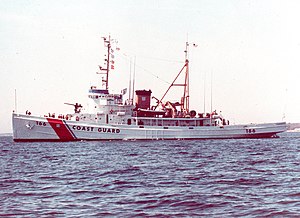USCGC Tamaroa (WMEC-166)

USCGC Tamaroa (WMEC-166) in 1990,
formerly USS Zuni (ATF-95) fleet tug (in 1943). |
|
| History | |
|---|---|
|
|
|
| Name: | USS Zuni (ATF-95) |
| Builder: | Commercial Iron Works |
| Laid down: | 8 March 1943 |
| Launched: | 31 July 1943 |
| Commissioned: | 9 October 1943 |
| Decommissioned: | 29 June 1946 |
| Struck: | 19 July 1946 |
| Nickname(s): | “The Mighty Z” |
| Fate: | Transferred to US Coast Guard |
|
|
|
| Name: |
|
| Commissioned: | 29 June 1946 |
| Decommissioned: | 1 February 1994 |
| Fate: | Scuttled 10 May 2017, 33 nautical miles off coast of Cape May, New Jersey |
| General characteristics | |
| Class and type: | Navajo |
| Displacement: | 1,731 long tons (1,759 t) |
| Length: | 205 ft 6 in (62.64 m) |
| Beam: | 39 ft 3.25 in (11.9698 m) |
| Draft: | 18 ft (5.5 m) |
| Propulsion: | 4 × General Motors model 12-278 diesels with diesel-electric drive: 3,010 shp (2,240 kW) |
| Speed: |
|
| Range: | 15,000 nmi (28,000 km; 17,000 mi) at 8 kn (15 km/h; 9.2 mph) (1990) |
| Complement: | 10 officers, 74 enlisted (1990) |
| Sensors and processing systems: |
Radar: SPN-25 (1961); no sonar. |
| Armament: |
|
USCGC Tamaroa (WAT/WMEC-166), originally the United States Navy Cherokee-class fleet tug USS Zuni (ATF-95), was a United States Coast Guard cutter. Following the U.S. Coast Guard custom of naming cutters in this class of ship after Native American tribes, she was named after the Tamaroa tribe of the Illiniwek tribal group.
The ship was one of 70 of her class built for the U.S. Navy. As the fleet tug USS Zuni, she saw action in World War II, including in the Marianas, Philippines, and Iwo Jima operations. After the war, she was transferred to the U.S. Coast Guard in 1946.
The bulk of Tamaroa′s U.S. Coast Guard career was spent patrolling, working in drug interdiction, and fisheries protection. She was the first Coast Guard cutter to arrive at the sinking ocean liner Andrea Doria in 1956.
Tamaroa was involved in the landmark 1969 tort case, Ira S. Bushey & Sons, Inc. v. United States, 398 F.2d 167 (2d Cir. 1968), which held the United States vicariously liable for the damage caused by Tamaroa to a drydock after an intoxicated U.S. Coast Guard seaman returning to his bunk aboard Tamaroa on 14 March 1963 opened drydock water valves, flooding and sinking the drydock and causing Tamaroa to list and slide off her blocks. In its ruling, the court found that an employer (in this case, the United States Government) will be held liable under respondeat superior if the actions of the employee (in this, a U.S. Coast Guard seaman) arise out of the course of his or her employment (in this case, as a U.S. Coast Guard seaman returning to his ship after leave) and cause damage (in this case, to Bushey & Sons′ drydock). The court held that "the ship is liable for anything ship-connected persons cause it to do."
...
Wikipedia
